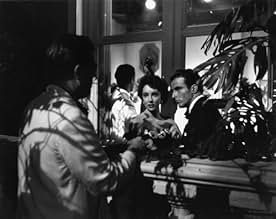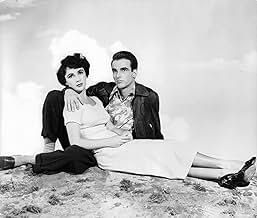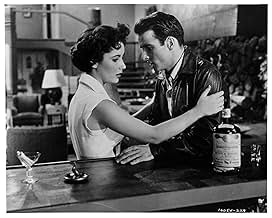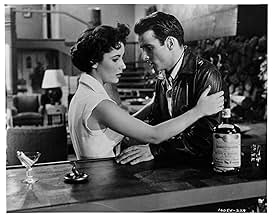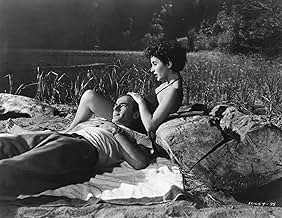NOTE IMDb
7,7/10
26 k
MA NOTE
Un pauvre jeune garçon travaille pour son riche oncle riche et finit par tomber amoureux de deux femmes.Un pauvre jeune garçon travaille pour son riche oncle riche et finit par tomber amoureux de deux femmes.Un pauvre jeune garçon travaille pour son riche oncle riche et finit par tomber amoureux de deux femmes.
- Réalisation
- Scénario
- Casting principal
- Récompensé par 6 Oscars
- 18 victoires et 12 nominations au total
Robert J. Anderson
- Eagle Scout
- (non crédité)
Gertrude Astor
- Bit Part
- (non crédité)
Avis à la une
A Place in the Sun (1951)
**** (out of 4)
Oscar-winning tale of a poor boy (Montgomery Clift) who goes to work for his uncle hoping to one day be rich like him. He falls in love with a small time woman (Shelley Winters) but soon gets a taste of the society life with a beauty (Elizabeth Taylor) and this is the start of his downfall. A PLACE IN THE SUN went home with six Oscars including Best Director for George Stevens and it's easy to see why he took home the award because there's so much going on in this picture yet he holds it together perfectly. The film is part melodrama, part message film, part romance and part suspense and Stevens really brings all of it together so perfectly that you can't help but get drawn into the story and feel every bit of pain that the characters do. The most amazing thing for me, and I'm not sure if it was meant to happen this way, but I really felt a lot of sympathy for the Clift character. Again, I'm not sure if this was the filmmakers intent but no matter how much I disagreed with what he was doing at the same time I never once hated him and even to the end I was hoping things would turn his way. I think some of this credit should be given to Clift who once again turns in a remarkable performance. I thought the shyness early on, the romance with Taylor and the hatred that someone is going to take away his dreams are all things that Clift perfectly nailed. The sequence on the boat towards the end is something masterfully performed by the actor. Taylor is also extremely good in her part even though of all the main characters I think hers is the most underwritten. Winters is also very good in her role of the woman who finds herself being left behind for someone better. I thought all the scenes between her and Clift, be it romantic or fighting, were full of wonderful chemistry. Anne Revere is a standout as Clift's mother and Raymond Burr is good in his few scenes. Again, a lot of credit has to go to Stevens because every aspect of the film works. The early love story between Clift and Shelley works. The love story between Clift and Taylor works. The downright suspense on the boat at night works. Even the ending manages to work. A PLACE IN THE SUN deserves its place as an all-time classic.
**** (out of 4)
Oscar-winning tale of a poor boy (Montgomery Clift) who goes to work for his uncle hoping to one day be rich like him. He falls in love with a small time woman (Shelley Winters) but soon gets a taste of the society life with a beauty (Elizabeth Taylor) and this is the start of his downfall. A PLACE IN THE SUN went home with six Oscars including Best Director for George Stevens and it's easy to see why he took home the award because there's so much going on in this picture yet he holds it together perfectly. The film is part melodrama, part message film, part romance and part suspense and Stevens really brings all of it together so perfectly that you can't help but get drawn into the story and feel every bit of pain that the characters do. The most amazing thing for me, and I'm not sure if it was meant to happen this way, but I really felt a lot of sympathy for the Clift character. Again, I'm not sure if this was the filmmakers intent but no matter how much I disagreed with what he was doing at the same time I never once hated him and even to the end I was hoping things would turn his way. I think some of this credit should be given to Clift who once again turns in a remarkable performance. I thought the shyness early on, the romance with Taylor and the hatred that someone is going to take away his dreams are all things that Clift perfectly nailed. The sequence on the boat towards the end is something masterfully performed by the actor. Taylor is also extremely good in her part even though of all the main characters I think hers is the most underwritten. Winters is also very good in her role of the woman who finds herself being left behind for someone better. I thought all the scenes between her and Clift, be it romantic or fighting, were full of wonderful chemistry. Anne Revere is a standout as Clift's mother and Raymond Burr is good in his few scenes. Again, a lot of credit has to go to Stevens because every aspect of the film works. The early love story between Clift and Shelley works. The love story between Clift and Taylor works. The downright suspense on the boat at night works. Even the ending manages to work. A PLACE IN THE SUN deserves its place as an all-time classic.
10bmacv
Bringing Theodore Dreiser's sprawling novel An American Tragedy to the screen must have been a daunting task, made harder by the constraints Paramount imposed on director George Stevens. The studio had lost big on a version made 20 years earlier, under Josef von Sternberg, and had little faith in a remake. So, hobbled by a tight budget, Stevens scaled back his ambitious plans but delivered, perhaps even to his own surprise, a superbly crafted and and powerfully sustained work of movie art.
He was lucky that Paramount, edgy about the story, gave him a cast that would guarantee not only good box office but solid performances as well. Montgomery Clift, Elizabeth Taylor and Shelly Winters take the principal roles, with, in the last third of the movie, extra oomph courtesy of Raymond Burr (in a role that may have nabbed him the Perry Mason franchise).
The jaws of the vise Clift finds himself squeezed into are class and sex. Barely educated, raised by stern members of a religious sect, he luckily (or not) happens to be the shirt-tail nephew of a prosperous entrepreneur who casually offers him work in his factory. Awkward and lonesome, Clift escapes the drudgery of his job by taking up with a mousy co-worker (Winters, toned way down from her platinum-bombshell image at the time). But his nose-to-the-grindstone ways attract the attention of his uncle, who rewards him with a promotion and an invitation up to the manor.
There he meets Taylor and launches an obsession about her, reinforced by a neon sign visible from his window that blazes her surname through his restless nights (she's another child of an industrial fortune, raised in wealth and privilege). Somehow, she falls for him and, need it be added, he for her despite his coming from the wrong side of the tracks (she hasn't the faintest notion that for people like him, life may not be the blithe affair it is for her).
Only one inconvenient fact keeps Clift from taking his rightful place in the sun: He's left Winters pregnant. The two worlds he occupies are destined to collide, and crash they do when Winters phones him, in the midst of a Hawaiian-themed luau at Taylor's summer place on the lake, to issue her ultimatum: Marry her or she'll spill their sordid secret. He leaves abruptly to meet Winters, desperately trying to assemble the plan which will seal three fates.
Stevens sustains an overwhelming, ominous momentum, unbroken by even a hint of levity (not even a single bit player is allowed to lapse into shtik). Languorous dissolves and superimposed images heighten the sense of inevitability as each scene, each event glides seamlessly into the next.
Maybe he wasn't able to pile on the exhaustive social commentary that bulked up Dreiser's novel, but everywhere there's sharp detail that he adroitly leaves to be noticed. When Clift shows up hours late at his intimate birthday party in Winter's cramped room, with the tiny table pushed up against her marble washstand, the ice cream has warmed to lumpy syrup (a self-homage to a similar scene in Steven's Alice Adams?). With an island combo playing merrily on, Clift sports a lei and eats pineapple out of its shell when Winters calls to break the spell and this South-Seas reverie is offered up not as Veblenesque excess, but merely as the way Taylor's crowd spend their days and evenings and nights in an endless round of heedless gaiety.
The apex of the film's crescendo is handled with tight, quiet assurance the reckoning in a rowboat upon a deserted lake. Dusk gathers among the pines like fog, the loons call back and forth, and the rippling waves reflect a demented flash into Clift's eye as he wrestles with his conscience. Winters natters nervously about the dreary life they'll spend together while his head swims with luminous visions of Taylor. Then, destiny catches.... Romantic but unsentimental, serious but without pretension, gripping without stooping to the manipulative, A Place in the Sun ranks as a masterpiece of American cinema.
He was lucky that Paramount, edgy about the story, gave him a cast that would guarantee not only good box office but solid performances as well. Montgomery Clift, Elizabeth Taylor and Shelly Winters take the principal roles, with, in the last third of the movie, extra oomph courtesy of Raymond Burr (in a role that may have nabbed him the Perry Mason franchise).
The jaws of the vise Clift finds himself squeezed into are class and sex. Barely educated, raised by stern members of a religious sect, he luckily (or not) happens to be the shirt-tail nephew of a prosperous entrepreneur who casually offers him work in his factory. Awkward and lonesome, Clift escapes the drudgery of his job by taking up with a mousy co-worker (Winters, toned way down from her platinum-bombshell image at the time). But his nose-to-the-grindstone ways attract the attention of his uncle, who rewards him with a promotion and an invitation up to the manor.
There he meets Taylor and launches an obsession about her, reinforced by a neon sign visible from his window that blazes her surname through his restless nights (she's another child of an industrial fortune, raised in wealth and privilege). Somehow, she falls for him and, need it be added, he for her despite his coming from the wrong side of the tracks (she hasn't the faintest notion that for people like him, life may not be the blithe affair it is for her).
Only one inconvenient fact keeps Clift from taking his rightful place in the sun: He's left Winters pregnant. The two worlds he occupies are destined to collide, and crash they do when Winters phones him, in the midst of a Hawaiian-themed luau at Taylor's summer place on the lake, to issue her ultimatum: Marry her or she'll spill their sordid secret. He leaves abruptly to meet Winters, desperately trying to assemble the plan which will seal three fates.
Stevens sustains an overwhelming, ominous momentum, unbroken by even a hint of levity (not even a single bit player is allowed to lapse into shtik). Languorous dissolves and superimposed images heighten the sense of inevitability as each scene, each event glides seamlessly into the next.
Maybe he wasn't able to pile on the exhaustive social commentary that bulked up Dreiser's novel, but everywhere there's sharp detail that he adroitly leaves to be noticed. When Clift shows up hours late at his intimate birthday party in Winter's cramped room, with the tiny table pushed up against her marble washstand, the ice cream has warmed to lumpy syrup (a self-homage to a similar scene in Steven's Alice Adams?). With an island combo playing merrily on, Clift sports a lei and eats pineapple out of its shell when Winters calls to break the spell and this South-Seas reverie is offered up not as Veblenesque excess, but merely as the way Taylor's crowd spend their days and evenings and nights in an endless round of heedless gaiety.
The apex of the film's crescendo is handled with tight, quiet assurance the reckoning in a rowboat upon a deserted lake. Dusk gathers among the pines like fog, the loons call back and forth, and the rippling waves reflect a demented flash into Clift's eye as he wrestles with his conscience. Winters natters nervously about the dreary life they'll spend together while his head swims with luminous visions of Taylor. Then, destiny catches.... Romantic but unsentimental, serious but without pretension, gripping without stooping to the manipulative, A Place in the Sun ranks as a masterpiece of American cinema.
The young and poor George Eastman (Montgomery Clift) leaves his religious mother and Chicago and arrives in California expecting to find a better job in the business of his wealthy uncle Charles Eastman (Herbert Heyes). His cousin Earl Eastman (Keefe Brasselle) advises him that there are many women in the factory and the basic rule is that he must not hang around with any of them.
George meets the worker of the assembly line Alice Tripp (Shelley Winters) in the movie theater and they date. Meanwhile, the outcast George is promoted and he meets the gorgeous Angela Vickers (Elizabeth Taylor) in a party at his uncle's house. Angela introduces him to the local high society and they fall in love with each other. However, Alice is pregnant and she wants to get married with George. During a dinner party at Angela's lake house with parents, relatives and friends, Alice calls George from the bus station and gives thirty minutes to him to meet her; otherwise she will crash the party and tells what has happened. George is pressed by the situation that ends in a tragedy.
"A Place in the Sun" is an unforgettable masterpiece by George Stevens and one of the best love stories ever made, with the perfect development of characters and situations. I watched this film for the first time on 14 June 2001 on cable television and yesterday I saw it again on a Paramount DVD with Extras telling details about the difficulties that George Stevens faced to bring Theodore Dreiser's novel "An American Tragedy" to a motion picture and casting. He had to sue Paramount to carry out the signed contract and get the agreed budget. Another interesting point is Shelley Winters, who was a sex symbol at that time, telling how she got the role of Alice Tripp. Elizabeth Taylor also tells funny things about her relationship with Montgomery Cliff. My vote is ten.
Title (Brazil): "Um Lugar Ao Sol" ("A Place in the Sun")
George meets the worker of the assembly line Alice Tripp (Shelley Winters) in the movie theater and they date. Meanwhile, the outcast George is promoted and he meets the gorgeous Angela Vickers (Elizabeth Taylor) in a party at his uncle's house. Angela introduces him to the local high society and they fall in love with each other. However, Alice is pregnant and she wants to get married with George. During a dinner party at Angela's lake house with parents, relatives and friends, Alice calls George from the bus station and gives thirty minutes to him to meet her; otherwise she will crash the party and tells what has happened. George is pressed by the situation that ends in a tragedy.
"A Place in the Sun" is an unforgettable masterpiece by George Stevens and one of the best love stories ever made, with the perfect development of characters and situations. I watched this film for the first time on 14 June 2001 on cable television and yesterday I saw it again on a Paramount DVD with Extras telling details about the difficulties that George Stevens faced to bring Theodore Dreiser's novel "An American Tragedy" to a motion picture and casting. He had to sue Paramount to carry out the signed contract and get the agreed budget. Another interesting point is Shelley Winters, who was a sex symbol at that time, telling how she got the role of Alice Tripp. Elizabeth Taylor also tells funny things about her relationship with Montgomery Cliff. My vote is ten.
Title (Brazil): "Um Lugar Ao Sol" ("A Place in the Sun")
This film is very different from anything of it's time that I have ever seen.A man has a one night stand with a coworker and gets her pregnant.THEN he meets the woman of his dreams,the woman with everything;charm,good looks and Daddy's money.We then have a man who is torn between choosing to have it all and doing the right thing.The result of his struggles ends up very tragically as you will see.I was very taken aback by the film's sexual overtones,though it was only hinted at,of course.With the barrage of remakes in recent years,I am surprised it has not been remade with stronger sexual content.This is a very enjoyable film with good performances all around,particularly those of Shelley Winters and Monty Clift.Liz Taylor's strong screen presence is also a delight.A definite thumbs up.
Poor and uneducated George Eastman (Montgomery Clift) unwittingly sets a trap for himself when he takes an entry-level job at his rich uncle's factory, which has a prohibition on male employees dating female employees. He just can't resist one of the girls in his department, the pitiful and whiny Alice Tripp (wonderfully played by Shelley Winters). Eventually, George gets a promotion and is invited into the upper echelon of his uncle's social world, where he meets wealthy and beautiful Angela Vickers (a breathless Elizabeth Taylor). Naturally, he falls in love with Angela. But a complication with Alice leaves him unable to break off his relationship with her.
That's the setup for this George Stevens-directed film that plays rather like a modern Greek tragedy. Everything about "A Place In The Sun" is high quality: the production design, the lavish Edith Head costumes, the wonderful editing, and that great B&W cinematography with those marvelous close-up shots, and overlapping dissolves that cleverly advance the plot.
All three principal actors do a splendid job. And they get solid support from a top notch secondary cast that includes Raymond Burr and the interesting Anne Revere.
The story clearly plays up social class differences, with the haughty rich looking down their noses at common workers. The film's tone varies from romantic, to sad, to suspenseful. At mysterious Loon Lake where significant events occur, the cinematic atmosphere is heavy with anticipation. It's like something out of a Hitchcock thriller.
I've never cared much for sad love stories, and the film does seem a tad dated. Still, it's so well made it can be appreciated by most everyone but the terminally shallow. It has a powerful ending, one that accentuates the acting accomplishments of Clift and especially of Taylor. "A Place In The Sun" was nominated for nine academy awards, and winner of six. I'd say this is one time when Oscar voters got it right.
That's the setup for this George Stevens-directed film that plays rather like a modern Greek tragedy. Everything about "A Place In The Sun" is high quality: the production design, the lavish Edith Head costumes, the wonderful editing, and that great B&W cinematography with those marvelous close-up shots, and overlapping dissolves that cleverly advance the plot.
All three principal actors do a splendid job. And they get solid support from a top notch secondary cast that includes Raymond Burr and the interesting Anne Revere.
The story clearly plays up social class differences, with the haughty rich looking down their noses at common workers. The film's tone varies from romantic, to sad, to suspenseful. At mysterious Loon Lake where significant events occur, the cinematic atmosphere is heavy with anticipation. It's like something out of a Hitchcock thriller.
I've never cared much for sad love stories, and the film does seem a tad dated. Still, it's so well made it can be appreciated by most everyone but the terminally shallow. It has a powerful ending, one that accentuates the acting accomplishments of Clift and especially of Taylor. "A Place In The Sun" was nominated for nine academy awards, and winner of six. I'd say this is one time when Oscar voters got it right.
Le saviez-vous
- AnecdotesIn her autobiography, Shelley Winters described producer and director George Stevens' way of working: "He would discuss the scene, but not the lines, and would photograph the second or third rehearsal so the scene had an almost improvisatory quality. Stevens would print the first take, then spend the next three hours minutely rehearsing the scene, then film it again. He explained to me that in this way he often got actors' unplanned reactions that were spontaneous and human and often exactly right. And often when actors overintellectualize or plan their reactions, they aren't as good."
- GaffesAlice Tripp is wearing different shoes when she starts walking home from the movie with George Eastman from those she is wearing when they near her residence. When Shelley Winters pointed out to director George Stevens that the brown and white shoes she was wearing turned to black when she walked around the corner, the director refused to re-shoot the scene. According to Winters, he said, "If they're looking at her feet, I can go home."
- ConnexionsFeatured in Hollywood: The Fabulous Era (1962)
Meilleurs choix
Connectez-vous pour évaluer et suivre la liste de favoris afin de recevoir des recommandations personnalisées
Détails
Box-office
- Budget
- 2 295 304 $US (estimé)
- Montant brut mondial
- 18 247 $US
- Durée2 heures 2 minutes
- Couleur
- Rapport de forme
- 1.37 : 1
Contribuer à cette page
Suggérer une modification ou ajouter du contenu manquant

Lacune principale
By what name was Une place au soleil (1951) officially released in India in English?
Répondre


